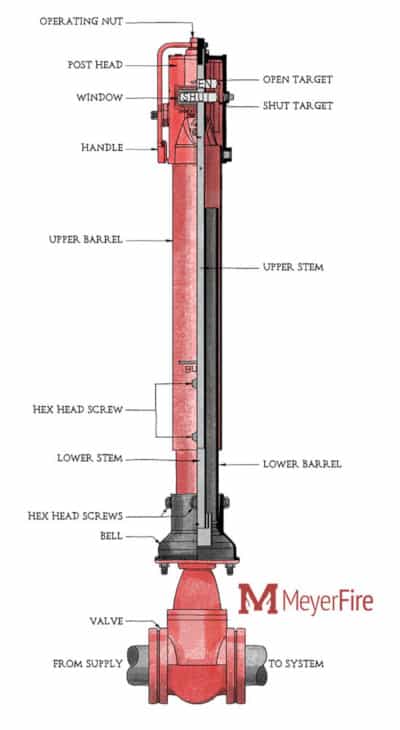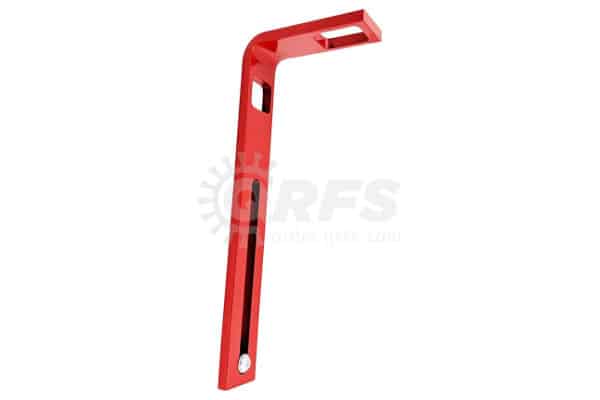
#365 – A Guide to Post Indicator Valve Requirements
When to use indicating valves on fire protection systems
Post indicator valves (PIV) play an important role in many fire protection systems, opening and closing the water supply from outside the building. But in 2010, the National Fire Protection Association’s (NFPA’s) post indicator valve requirements changed. And while the new rules gave system designers more options, they also made it less clear when they’re needed.
This blog explores the value of adding a post indicator valve to a fire protection system. We also dig into when these devices are called for by NFPA.

Installing a post indicator valve in your fire protection system? Be sure to check out our universal PIV wrench and PIV tamper switch. We also carry post indicator valves on request. Simply call us at +1 (888) 361-6662 or email support@qrfs.com.
What’s the purpose of a post indicator valve?
Post indicator valves are generally used to control the flow of water to a sprinkler system, hydrant, or another device with underground piping. Since the first post indicator valve was installed in 1974, this equipment has been a mainstay of fire protection applications where responding firefighters need a clear indication of whether an out-of-sight valve is open or closed. The valve assembly also serves as an easy way to stop the flow of water from the water supply main during emergencies or routine maintenance.
During a building fire, the collapse of an exterior wall could damage water supply mains or create new openings to the water supply. A post indicator valve allows firefighters to cut off supply to compromised areas, ensuring their efforts aren’t hampered by the loss of pressure, or water being diverted to the wrong places.
But over the last decade, NFPA relaxed its post indicator valve requirements. MeyerFire notes that the decision stems from the effectiveness of fire sprinkler systems in controlling fires before walls reach the point of collapse, as well as a desire to reduce the cost of sprinkler installations. In fact, MeyerFire points out that code references accounting for building collapse now only appear indirectly, via requirements to place hydrants and post indicator valves a sufficient distance from a structure.
Incidentally, post indicator valves are also used in industrial or domestic settings to transport process water, which is not safe to drink. Red post indicator valves are designated for stopping fires, while yellow, green, and blue ones indicate domestic or industrial purposes.

Post indicator valve detail: here’s how they work
Also known as PIVs, indicator posts, I posts, IPs, wall posts, or post indicators, post indicator valves can be easily recognized by a consistent symbol: “PIV” inside a circle. The assembly typically consists of a conventional gate or butterfly valve installed on the fire system water main. The indicator post is installed on a mounting plate on the bonnet and protrudes from the ground or wall.
The top of an indicator post features a lockable actuator that looks like a red metal steering wheel or a wrench/handle. Moving the actuator opens and closes the valve. A glass or plastic window at the top of the indicator post clearly shows notifications that announce whether the valve is open or shut.
Universal PIV wrenches can be adjusted to fit most indicating posts. Here’s how they work: With a tamper-proof slide nut, the locking wrench attaches to the square operating nut of a vertical indicator valve, allowing the underground valve to be operated. The slide nut secures one side of the indicator valve wrench to an eye bolt or loop that’s used to lock the wrench in place.
Watch this video for a demonstration of how post indicator valves work with a wrench/handle:
There are three main types of post indicator valves:
- Ground posts. The base of this indicator post is buried in the ground. It is generally operated by a lockable handle or wrench. Ground posts are used when the valve is located outside the building.
- Wall posts. This short indicator post is typically bolted horizontally to the wall of the building through a flange. It is used when water mains pass through a wall cavity and is operated by a handwheel. However, wall indicating posts are generally less preferred than other types because they are the most at risk during a building collapse.
- Pedestal posts. This indicator post looks like a ground post but is bolted through a flange to a horizontal surface (usually a platform of concrete), instead of coming out of the ground. It’s used when the valve is located inside a building, and the water mains are underground. It is also operated through a lockable handle or wrench.
Indicator posts can have adjustable or fixed lengths to account for different bury depths. Adjustable posts typically have a telescoping underground section, enabling field adjustment to the exact bury depth that’s needed. Electronic PIVs are also available that communicate with a fire alarm system whenever the valve is opened or closed.
What are NFPA post indicator valve requirements?
The International Fire Code (IFC) states that private fire service mains must be installed per NFPA 24: Standard for the Installation of Private Fire Service Mains and Their Appurtenances. NFPA 24 regulates system requirements between water supply mains and service entries into a building.
Before 2010, NFPA 24’s post indicator valve requirements were clear: a listed post indicator valve was required on nearly every connection from a private fire service main to a building. A few special exceptions were permitted—such as an indicating valve in a pit—but they required approval from the authority having jurisdiction (AHJ).
Starting with the 2010 edition, however, NFPA 24 stopped mandating the exclusive use of post indicator valves for isolating a building’s fire protection systems. Instead, the 2022 edition of NFPA 24 (6.2.9) offers the following options:
- A post indicator valve at least 40 feet (12 m) from the building, unless certain distance exceptions covered below are met.
- A wall post indicator valve can be used “on risers located within the building, either a nonrising stem gate valve with a wall post indicator or a listed butterfly valve with an indicating handle extending out through the building wall.”
- An indicating valve may be placed in a pit if it is “of a size to permit access for inspection, operation, testing, maintenance, and removal of equipment contained therein.” (6.4.2) Also, “valve pits located on the discharge pipe of an elevated tank shall be designed in accordance with NFPA 22.” (6.4.1)
- A backflow preventer with an indicating valve at least 40’ from the building (unless distance exceptions covered below are met).
- A non-indicating valve, such as an underground gate valve in an approved roadway box with T-wrench at least 40’ from the building (unless distance exceptions covered below are met).
- Control valves installed in a fire-rated room accessible from the exterior.
- Control valves in a fire-rated stair enclosure accessible from the exterior, as permitted by the AHJ.
- Any other valve type or location as permitted by the AHJ.
The 40′ building distance exceptions to post indicator valves and backflow preventers are the same. If a building is less than 40’ tall or “a property line or other physical barriers make it impossible,” or “a building driveway or fire access roadways or other building traffic make it impractical,” valves can be located less than 40’ from the structure. The first two exceptions apply to non-indicating valves. However, read this carefully: none of them can be closer to the building than the height of the wall facing the device. This rule, of course, accounts for a potential building collapse.

For systems that follow the guidelines of NFPA 13: Standard for the Installation of Sprinkler Systems, the waters are even murkier. The only guidance from the 2022 edition concerning post indicator valves is in Section 16.9.8. While it doesn’t weigh in on when these valve assemblies should be used, it states that “the top of the post must be 32 in. to 40 in. (800 mm to 1000 mm) above the final grade” when they are. The section requires post indicator valves to be protected from mechanical damage. It also notes that the grading requirement doesn’t apply to wall post indicator valves.
The 2019 edition of NFPA 14: Standard for the Installation of Standpipe and Hose Systems offers the most specific post indicator valve requirements. Except for fire department connections, Section 6.3.6.1.1 says that every water supply should have a listed indicating valve in an approved location. Post indicator valves are most commonly used to fulfill this requirement.
A.6.3.6.1.1 drives home the preference for post indicator valves, offering a list of options in preferred order:
- A listed indicating valve at each connection into the building that is located at least 40’ from the building (if space permits)
- Control valves in a cutoff stair tower or valve room accessible from the outside
- Valves located in risers with indicating posts arranged for outside operation
- Key-operated valves in each connection into the building
NFPA 14 (6.3.6.1) also permits other alternatives with AHJ approval, such as wall post indicating valves and underground valves with a roadway box and T-wrench.
AHJs and insurers often add their own post indicator valve requirements. Always check local codes and with insurance providers for the most accurate fire protection system mandates.

Interpreting post indicator valve requirements determines when they’re needed for fire protection systems
Post indicator valves can save lives during a fire emergency, ensuring firefighters receive the water pressure they need. While NFPA has relaxed its post indicator valve requirements, they remain a preferred method of controlling the flow of water to a fire protection system.

Installing a post indicator valve in your fire protection system? Be sure to check out our universal PIV wrench and tamper switch. We also carry post indicator valves on request. Simply call us at +1 (888) 361-6662 or email support@qrfs.com.
This blog was originally posted at blog.qrfs.com. Check us out at Facebook.com/QuickResponseFireSupply or on Twitter @QuickResponseFS.